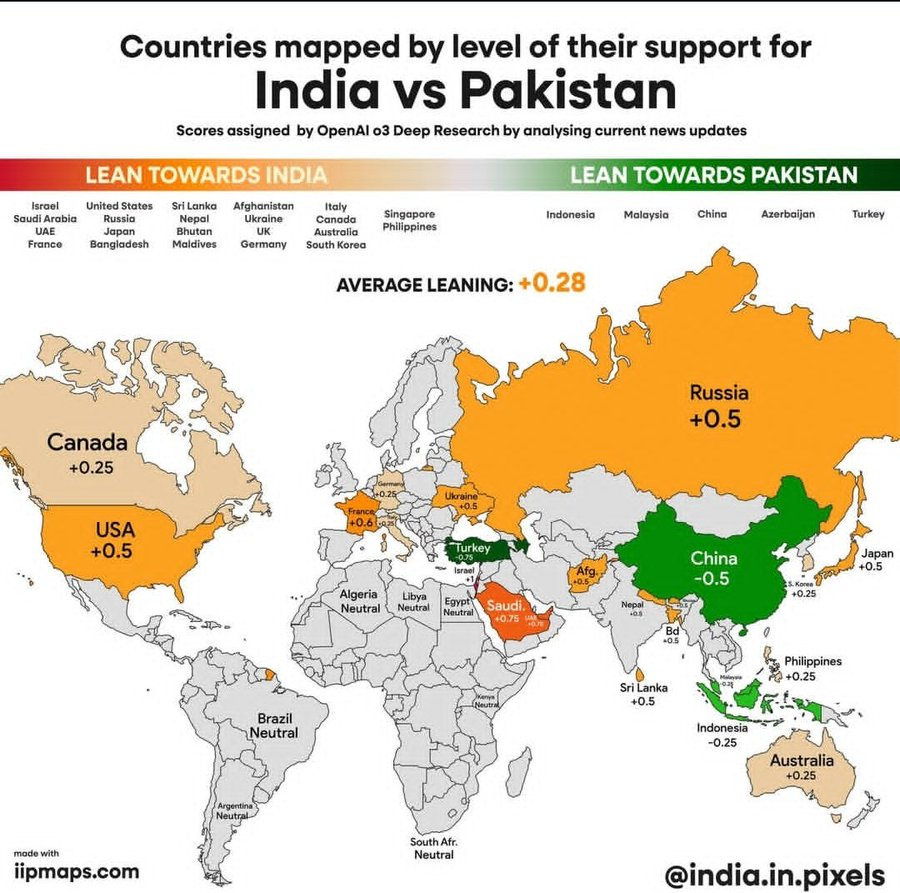A new map released by India in Pixels on May 29, 2025, titled “Countries Mapped by Level of Their Support for India vs. Pakistan,” has sparked global discussions about shifting geopolitical alliances in South Asia. The map, based on scores assigned by OpenAI’s O3 Deep Research through analysis of current news updates, highlights a surprising tilt: Saudi Arabia, Bangladesh, and the UAE are among the nations leaning firmly toward India, with scores of +0.75, +0.5, and +0.75 respectively. This marks a significant departure from historical alignments, particularly for Pakistan, which has long counted on support from these countries.
The map, which assigns an average global leaning of +0.28 toward India, paints a stark picture of international sentiment. Saudi Arabia and the UAE, traditionally seen as close allies of Pakistan due to shared religious and economic ties, appear to be recalibrating their positions. Analysts point to recent developments as the cause. Saudi Arabia’s growing economic partnership with India—bilateral trade reached $52 billion in 2024—has deepened ties, with India becoming a key market for Saudi oil and a partner in Vision 2030 projects. The UAE, similarly, has strengthened its relationship with India through investments in technology and infrastructure, including a $2 billion deal in 2024 to develop AI hubs in Bangalore.
Bangladesh’s support for India, while less surprising given historical tensions with Pakistan since the 1971 Liberation War, underscores a regional shift. Dhaka’s recent alignment with New Delhi on counterterrorism and trade—coupled with a cooling of relations with Islamabad over border security issues—has solidified its stance. “Bangladesh sees India as a stabilizing force in the region,” said a Dhaka-based political analyst, speaking anonymously. “Pakistan’s internal challenges and its focus on military spending over development have pushed us closer to India.”
The map also reveals broader trends. The USA (+0.5), Canada (+0.25), and Japan (+0.5) lean toward India, reflecting strategic partnerships aimed at countering China’s influence in the Indo-Pacific. Conversely, China (-0.5) and Turkey (-0.25) show a clear tilt toward Pakistan, aligning with their historical and military ties. Russia’s slight lean toward India (+0.5) is notable, given its long-standing arms trade with New Delhi, though it maintains relations with Islamabad.
This data comes amid heightened India-Pakistan tensions, particularly after a series of border skirmishes in Kashmir earlier this year. The shifting allegiances could have far-reaching implications for regional stability, with Saudi Arabia, the UAE, and Bangladesh’s support for India potentially isolating Pakistan further on the global stage. As Foreign Policy reported in its May 26, 2025, article on Turkey’s arms exports, Pakistan’s reliance on Turkish firearms has grown, but this map suggests that such partnerships may not be enough to counterbalance the loss of traditional allies.
For now, the map serves as a stark reminder of the fluid nature of international relations—and the challenges Pakistan faces as it navigates a world increasingly leaning toward its rival.






